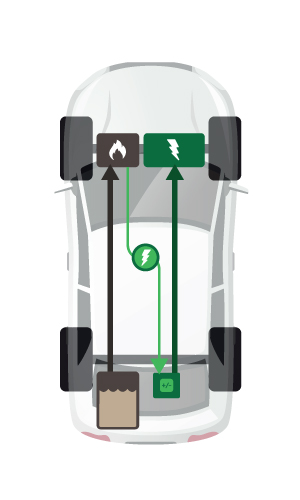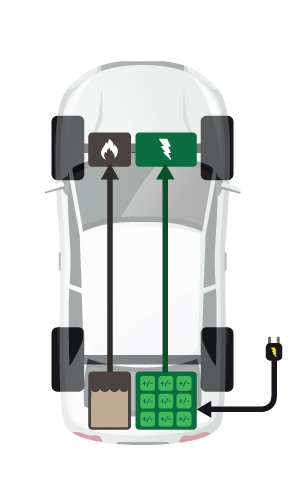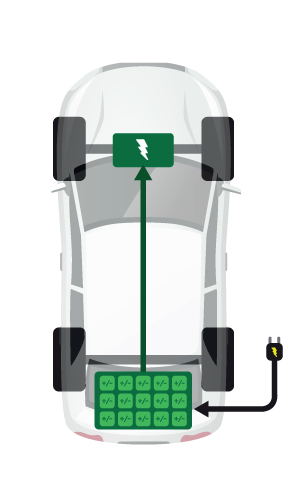Electrified vehicles are powered by an electric motor, instead of a traditional petrol or diesel combustion engine. This means they’re more environmentally friendly than a petrol or diesel vehicle and offer lower running costs.
Considering an Electric Vehicle (EV) ?
Here’s everything you need to know…
If you’re thinking of making the switch to an EV but are feeling daunted, we can help. There’s more information to explore online but on this page we share the basics. If you’ve already made the switch and are new to driving an EV, we’ve created a handy guide of things to consider in our EV Driver Guide
What types of electrified vehicles are there ?
Hybrid Electric Vehicle
(HEV)

This combines a small battery, an electric motor and a traditional combustion engine. It travels a few miles on electric power before switching back to the combustion engine. The battery is charged through the engine combined with regenerative braking (this means that as the car slows down, its motion is converted into energy that’s then stored in the battery).
a few miles
Petrol tank
No plug-in charging
Plug-in Hybrid Vehicle
(PHEV)

This also has an electric motor and a traditional combustion engine, but it has a larger battery than the HEV. In the same way as the HEV, the battery is partly charged by the engine and regenerative braking - but you’ll need to plug it in and completely charge it to access the full benefits of the electric range.
20 - 40 miles
Petrol tank
Plug-in charging needed for electric range
Battery Electric Vehicle
(BEV)

This has a much larger battery than a PHEV, with a fully electric powertrain (the powertrain takes the energy stored in the battery and supplies it to the motors). This vehicle can be charged at home or on the public charging network. Battery range depends on many factors but longer journeys (beyond the vehicle range) will require planning, to incorporate sufficient charging stops.
up to several hundred miles
No petrol tank
Plug-in charging needed
Frequently asked questions
Charging an EV (Electric Vehicle)
How do I charge an EV?
There are four main types of charging – slow, fast, rapid and super/ultra-rapid charging. The higher the power output – given in kW (kilowatts) – the faster the charge.
Plug-in vehicles can be charged using either a standard 3-pin socket, or a dedicated EV charge point. A home charge unit will typically be three times faster than a domestic socket, which will make a significant difference when charging a 50kWh+ battery.
To charge your EV, simply use the charging cable(s) provided with your vehicle. One end plugs into the socket on your vehicle, and the other end into the EV charge point or a standard 3-pin socket.
Most EVs come with a mobile app that allows you to monitor charging, and even set the climate control before you get in the car. Great for clearing the ice on a winter’s day. Each vehicle varies but your manufacturer handbook should outline the specific charging instructions for yours. There are also plenty of video tutorials online.
Can someone unplug my car or steal my cable?
How do I find a public charge point?
What should I do if my vehicle won’t charge?
EV range (the number of miles you can drive on one charge)
How far can I travel between charges?
Which factors affect battery range?
What is regenerative braking?
I’m concerned my EV isn’t delivering the real-life range I should expect
Additional equipment
Can accessories such as roof bars be fitted to an EV?
Can I tow a caravan or trailer with an EV?
EV maintenance
How do I maintain my EV?
What happens if I run out of electricity or break down?
Similar to the fuel gauge on a petrol or diesel vehicle, an EV has a battery gauge and a range indicator. As you near low-battery level, the vehicle will alert you with warning signs and graphics on the dashboard. What to do if you break down.
All major breakdown recovery firms now cover EVs. Some recovery vehicles are equipped with a power pack, but you’re more likely to be taken to the nearest charging station or to your destination. Electric vehicles cannot be towed, as this can damage the electric motor.
